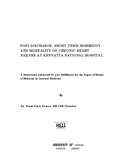| dc.description.abstract | Objective: To ascertain the mortality and rehospitalization rates among patients discharged with
a diagnosis of congestive cardiac failure.
Design: Prospective observational study
Setting: Kenyatta National Hospital, Nairobi, Kenya.
Subjects: one hundred and fifty five (155) consecutive medical ward discharges with an
admission diagnosis of congestive cardiac failure meeting Framingham criteria.
Results: The study was conducted from July 2008 to March 2009. One hundred and fifty five
patients were recruited and followed up for a mean duration of 138 days. 55.3% were female and
the average age of the population was 47years. On admission, 91% were in NYHA class 3 and 4,
31% had valvular heart disease, mainly rheumatic valve disease while 69% had non valvular
disease. 40% had the admission during the study period as the index admission while 60% had
had one or more than one previous admissions. During follow up, 35 patients died out of 138
giving a 4 - 6 months mortality rate of25.4% (95% CI 18.l-32.6). When 17 patients lost to
follow up are included in the analysis and presumed dead, the mortality rate is 37.7% (95% CI
29.6-45.8). The average time to death was 72.2 days. When categorized into nonvalvular and
valvular heart disease patients, the mortality rate is 21.3% (95% CI 13.1-29.5) and 40.5% (95%
CI 28.7-52.3) respectively. Among non valvular heart disease patients, significant predictors of
increased mortality were a duration of heart failure diagnosis or symptoms of less than 30days
prior to admission (O.R 7.0, 95% CI 2-25, p = 0.001) and an elevated urea level on admission
(O.R 5.0, 95% CI 1.42-17.24, p=0.008). Among valvular heart disease patients only a NYHA
class 3 or 4 at 4-12 weeks post discharge was associated with increased mortality (O.R 10, 95%
CI l.2-100, p=O.O17). 38% of the population was rehospitalized. The rehospitalization rate per
patient was 1.29. The time to rehospitalization was 69.8 days (±60.28) and 29.5% of the
population was rehospitalized once while 6.2% and 2.3% were rehospitalized twice and three
times respectively. The rate of death or first rehospitalization was 49.2% (95% CI 40.6-57.8).
Significant predictors of increased rehospitalization among non valvular heart disease patients
included a low potassium level on admission (OR 6.15,95% CI 1.9-21.3, p=O.OOI),not receiving
an ACE-Ion clinic review at 4-12weeks (OR 4.1,95% CI 1.3-12.9, p=0.013) and receiving
aldactone on discharge (OR 3.22, 95% CI 1.12-9.23, p=0.026) and on clinic review (OR 9.3,
95% CI 1.13-76.9, p=0.015).
Conclusion: the 4 - 6 month mortality of patients with CHF is 25-38% in our population while
the rehospitalization rate is 38%. Various factors including a shorter duration of CHF prior to
admission, hyperuriceamia on admission and poor NYHA score are associated with increased
mortality. Factors associated with increased rehospitalization include hypokalemia on admission,
not receiving an ACE-J on discharge and use of aldactone. | en |
| dc.description.department | a
Department of Psychiatry, University of Nairobi, ; bDepartment of Mental Health, School of Medicine,
Moi University, Eldoret, Kenya | |

